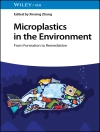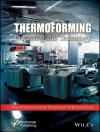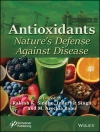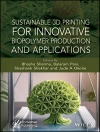Edited by a team of highly respected researchers combining their expertise in chemistry, physics, and medicine, this book focuses on the use of rutheniumcontaining complexes in artificial photosynthesis and medicine.
Following a brief introduction to the basic coordination chemistry of ruthenium complexes and their synthesis in section one, as well as their photophysical and photochemical properties, the authors discuss in detail the major concepts of artificial photosynthesis and mechanisms of hydrogen production and water oxidation with ruthenium in section two. The third section of the text covers biological properties and important medical applications of ruthenium complexes as therapeutic agents or in diagnostic imaging.
Aimed at stimulating research in this active field, this is an invaluable information source for researchers in academia, health research institutes and governmental departments working in the field of organometallic chemistry, green and sustainable chemistry as well as medicine/drug discovery, while equally serving as a useful reference also for scientists in industry.
Зміст
About the Editors xv
Preface xvii
Acknowledgments xix
Section I Introduction 1
1 Karen J. Brewer (1961–2014): A Bright Star that Burned Out Far Too Soon 3
Seth C. Rasmussen
1.1 Introduction 3
1.2 Early Years 4
1.3 Graduate Studies and Clemson University 6
1.4 Postdoctoral Research and the University of California, Berkeley 11
1.5 Washington State University: Beginning an Independent Career 13
1.6 Move to Virginia Tech 15
1.7 Collaboration with Brenda Winkel and the Study of Metal-DNA Interactions 16
1.8 A Return to Where It All Started: Photochemical H2 Production 18
1.9 A Career Cut Tragically Short 19
1.10 Karen’s Legacy 20
Acknowledgments 20
References 20
2 Basic Coordination Chemistry of Ruthenium 25
Mark A.W. Lawrence, Jimmie L. Bullock, and Alvin A. Holder
2.1 Coordination Chemistry of Ruthenium 25
2.1.1 The Element 25
2.1.2 Stereochemistry and Common Oxidation States 26
2.1.2.1 Ruthenium in Low Oxidation States 27
2.1.2.2 Chemistry of Ruthenium(II) and (III) 31
2.1.2.3 Higher Oxidation States of Ruthenium 36
2.1.3 Conclusion 37
References 37
Section II Artificial Photosynthesis 43
3 Water Oxidation Catalysis with Ruthenium 45
Andrea Sartorel
3.1 Introduction 45
3.1.1 Energy Issue and Energy from the Sun 45
3.1.2 Photosynthesis and Solar Fuels 46
3.1.3 Water Oxidation 48
3.1.4 Artificial Water Oxidation 49
3.2 Ruthenium in Water Oxidation Catalyst 50
3.2.1 Ruthenium Oxide 50
3.2.2 Molecular Ruthenium WOC 52
3.2.2.1 Meyer’s Blue Dimer 53
3.2.2.2 The Ru-Hbpp Catalyst 54
3.2.2.3 Single-Site Ru-WOCs 55
3.2.2.4 Heptacoordinated Ru Intermediates 56
3.2.3 Polyoxometalates: The Bridge Between Metal Oxides and Coordination Complexes 57
3.3 Conclusions and Perspectives 60
References 61
4 Ruthenium- and Cobalt-Containing Complexes and Hydrogenases for Hydrogen Production 67
Michael J. Celestine, Raj K. Gurung, and Alvin A. Holder
4.1 Introduction 67
4.2 (A) Ruthenium- and Cobalt-Containing Complexes for Hydrogen Production 68
4.2.1 Nonbridged Systems 68
4.2.2 Bridged Systems 70
4.3 (B) Ruthenium(II)-Containing Complexes and Hydrogenases for Hydrogen Generation in Aqueous Solution 77
4.3.1 Hydrogenases 77
4.3.2 Hydrogenases with Ruthenium(II) Complexes 78
4.4 Conclusions 84
References 85
Section III Applications in Medicine 89
5 Ligand Photosubstitution Reactions with Ruthenium Compounds: Applications in Chemical Biology and Medicinal Chemistry 91
Samantha L. Hopkins and Sylvestre Bonnet
5.1 Introduction 91
5.2 Caging and Uncaging Biologically Active Ligands with a Nontoxic Ruthenium Complex 92
5.3 Caging Cytotoxic Ruthenium Complexes with Organic Ligands 96
5.4 Low-Energy Photosubstitution 100
5.4.1 Introduction 100
5.4.2 Modulating Ru Photophysics by Ligand Modulation 100
5.4.3 Upconversion (UC) 105
5.4.3.1 Triplet–Triplet Annihilation Upconversion 105
5.4.3.2 Upconverting Nanoparticles (UCNPs) 106
5.4.3.3 Two-Photon Absorption (TPA) Photosubstitution 109
5.5 Conclusions 110
References 111
6 Use of Ruthenium Complexes as Photosensitizers in Photodynamic Therapy 117
Lothar Lilge
6.1 Introduction 117
6.2 The Basics of Photodynamic Therapy 118
6.2.1 Singlet Oxygen Production 120
6.2.2 Other Radical Production 120
6.2.3 PDT Dose Definition 120
6.2.3.1 PDT Dosimetry In Vitro 122
6.2.3.2 PDT Dosimetry In Vivo 124
6.2.3.3 Oxygen Consumption Model 125
6.2.3.4 In Vivo Tissue Response Models 125
6.2.4 PDT and Immunology 126
6.3 Status of Ru Photosensitizing Complexes 126
6.3.1 Photostability for Ru-PS Complexes 128
6.3.2 Long Wavelength Activation of Ru(II)-PS Complexes 128
6.4 Issues to Be Considered to Further Develop Ru-Based Photosensitizers 129
6.4.1 Subcellular Localization 130
6.4.2 Ruthenium Complex Photosensitizers and the Immune Response 131
6.5 Future Directions for Ru-PS Research 131
6.6 Conclusion 132
References 132
7 Photodynamic Therapy in Medicine with Mixed-Metal/Supramolecular Complexes 139
Jimmie L. Bullock and Alvin A. Holder
7.1 Introduction 139
7.2 Platinum and Rhodium Centers as Bioactive Sites 140
7.2.1 Platinum(II)-Based Chemotherapeutics 140
7.2.2 Rhodium(III) as a Bioactive Site 141
7.3 Supramolecular Complexes as DNA Photomodification Agents 142
7.4 Mixed-Metal Complexes as Photodynamic Therapeutic Agents 143
7.4.1 Photosensitizers with a Ru(II)Metal Center Coupled to Pt(II) Bioactive Sites 143
7.4.1.1 Binuclear Complexes with Ru(II) and Pt(II)Metal Centers with Bidentate Ligands 143
7.4.1.2 Binuclear and Trinuclear Complexes with Ru, Pt with Tridentate Ligands 146
7.4.2 Photosensitizers with a Ru(II) Metal Center Coupled to Rh(III) Bioactive Sites 147
7.4.2.1 Trinuclear Complexes with Ru(II), Rh(III), and Ru(II) Metal Centers 147
7.4.2.2 Binuclear Complexes with Ru(II) and Rh(III) Metal Centers 149
7.4.3 Photosensitizers with a Ru(II) Metal Cenetr Coupled to Other Bioactive Sites 150
7.4.3.1 Binuclear Complexes with Ru(II) and Cu 150
7.4.3.2 Binuclear Complexes with Ru(II) and Co(III) Metal Centers 151
7.4.3.3 Binuclear Complexes with Ru (II) and V(IV) Metal Centers 151
7.4.3.4 Applications of Ru(II) Metal Centers in Nanomedicine 152
7.5 Summary and Conclusions 155
Abbreviations 156
References 157
8 Ruthenium Anticancer Agents En Route to the Tumor: From Plasma Protein Binding Agents to Targeted Delivery 161
Muhammad Hanif and Christian G. Hartinger
8.1 Introduction 161
8.2 Protein Binding Ru III Anticancer Drug Candidates 163
8.2.1 Ru III Anticancer Drug Candidates Targeting Primary Tumors 163
8.2.2 Antimetastatic Ru III Compounds 165
8.3 Functionalization of Macromolecular Carrier Systems with Ru Anticancer Agents 166
8.3.1 Proteins as Delivery Vectors for Organometallic Compounds 166
8.3.2 Polymers and Liposomes as Delivery Systems for Bioactive Ruthenium Complexes 168
8.3.3 Dendrimers 169
8.4 Hormones, Vitamins, and Sugars: Ruthenium Complexes Targeting Small Molecule Receptors 169
8.5 Peptides as Transporters for Ruthenium Complexes into Tumor Cells and Cell Compartments 173
8.6 Polynuclear Ruthenium Complexes for the Delivery of a Cytotoxic Payload 174
8.7 Summary and Conclusions 175
Acknowledgments 175
References 176
9 Design Aspects of Ruthenium Complexes as DNA Probes and Therapeutic Agents 181
Madeleine De Beer and Shawn Swavey
9.1 Introduction 181
9.2 Physical Interaction to Disrupt DNA Structure 181
9.2.1 Irreversible Covalent Binding 182
9.2.2 Intercalation 184
9.2.3 Additional Noncovalent Binding Interactions 185
9.3 Biological Consequences of Ru-Complex/DNA Interactions 186
9.4 Effects of Ru Complexes on Topoisomerases and Telomerase 191
9.5 Summary and Conclusions 196
References 197
10 Ruthenium-Based Anticancer Compounds: Insights into Their Cellular Targeting and Mechanism of Action 201
António Matos, Filipa Mendes, Andreia Valente, Tânia Morais, Ana Isabel Tomaz, Philippe Zinck, Maria Helena Garcia, Manuel Bicho, and Fernanda Marques
10.1 Introduction 201
10.2 Cellular Uptake 204
10.3 DNA and DNA-Related Cellular Targets 205
10.4 Targeting Signaling Pathways 207
10.5 Targeting Enzymes of Specific Cell Functions 207
10.6 Targeting Glycolytic Pathways 209
10.7 Macromolecular Ruthenium Conjugates: A New Approach to Targeting 211
10.8 Conclusions 214
References 215
11 Targeting cellular DNA with Luminescent Ruthenium(II) Polypyridyl Complexes 221
Martin R. Gill and Jim A. Thomas
11.1 Introduction 221
11.1.1 DNA-Binding Modes of Small Molecules 222
11.1.2 Metal Complexes and DNA 223
11.2 [Ru(bpy)2(dppz)]2+ and the DNA “Light-Switch” Effect 224
11.3 Cellular Uptake of RPCs and Application as DNA-Imaging Agents 226
11.3.1 Mononuclear Complexes 226
11.3.2 Dinuclear Complexes 228
11.3.3 Cyclometalated Systems 228
11.4 Alternative Techniques to Assess Cellular Uptake and Localization 231
11.5 Toward Theranostics: luminescent RPCs as Anticancer Therapeutics 232
11.6 Summary and Conclusions 234
References 235
12 Biological Activity of Ruthenium Complexes With Quinoline Antibacterial and Antimalarial Drugs 239
Jakob Kljun and Iztok Turel
12.1 Introduction 239
12.2 Antibacterial (Fluoro)quinolones 240
12.2.1 Quinolones and Their Interactions with Metal Ions 241
12.2.2 Ruthenium and Quinolones 241
12.2.3 Ruthenium and HIV Integrase Inhibitor Elvitegravir 245
12.3 Antibacterial 8-Hydroxyquinolines 246
12.3.1 Mode of Action of 8-Hydroxyquinoline Agents 246
12.3.2 Ruthenium and 8-Hydroxyquinolines 247
12.4 Antimalarial 4-Aminoquinolines 248
12.4.1 Mechanism of Action of Antimalarial Quinoline Agents 248
12.5 Metallocene Analogues of Chloroquine 249
12.6 Conclusions 252
References 252
13 Ruthenium Complexes as NO Donors: Perspectives and Photobiological Applications 257
Loyanne C.B. Ramos, Juliana C. Biazzotto, Juliana A. Uzuelli, Renata G. de Lima, and Roberto S. da Silva
13.1 Introduction 257
13.2 Photochemical Processes of Some Nitrogen Oxide Derivative–Ruthenium Complexes 258
13.2.1 Metal-Ligand Charge-Transfer Photolysis of {Ru-NO}6 258
13.2.2 Nitrosyl Ruthenium Complexes: Visible-Light Stimulation 261
13.3 Photobiological Applications of Nitrogen Oxide Compounds 265
13.3.1 Photovasorelaxation 265
References 268
14 Trends and Perspectives of Ruthenium Anticancer Compounds (Non-PDT) 271
Michael A. Jakupec, Wolfgang Kandioller, Beatrix Schoenhacker-Alte, Robert Trondl, Walter Berger, and Bernhard K. Keppler
14.1 Introduction 271
14.2 Ruthenium(III) Compounds 272
14.2.1 NAMI-A 273
14.2.1.1 Biotransformation 273
14.2.1.2 Antimetastatic Activity 274
14.2.1.3 Mode of Action 274
14.2.1.4 Clinical Studies and Perspectives 275
14.2.2 KP1019/NKP-1339 276
14.2.2.1 Tumor Targeting Mediated by Plasma Proteins 276
14.2.2.2 Activation by Reduction 277
14.2.2.3 Mode of Action 278
14.2.2.4 Clinical Studies and Perspectives 281
14.3 Organoruthenium(II) Compounds 282
14.3.1 Ruthenium(II)–Arene Compounds in Preclinical Development 282
14.3.1.1 Organoruthenium Complexes Bearing Bioactive Ligand Scaffolds 284
14.3.1.2 Cytotoxic Organoruthenium Complexes without Activation by Aquation 285
References 286
15 Ruthenium Complexes as Antifungal Agents 293
Claudio L. Donnici, Maria H. Araujo, and Maria A. R. Stoianoff
15.1 Introduction 293
15.2 Antifungal Activity Investigations of Ruthenium Complexes 304
15.2.1 Ruthenium Complexes with Activity against Several Pathogenic Fungi Species: Dinuclear, Trinuclear, and Tetranuclear ruthenium Polydentate Polypyridil ligands, Heterotrimetallic di-Ruthenium-Mono-Palladium Complexes, Dinuclearbis-β-Diketones and Pentadithiocarbamate Ligands 304
15.2.2 Aromatic and Heteroaromatic Ligands in Ru Monometallic Centers (Pyridine, Phenantroline, Terpyridine, Quinoline, and Phenazine) 305
15.2.3 Schiff bases, Thiosemicarbazones, and Chalcones 307
15.2.3.1 Schiff bases (Tetradentate Salen Like, Tridentate, and bidentate) 307
15.2.3.2 Thiosemicarbazones 309
15.2.3.3 Chalcone Derivatives 310
15.2.4 Other ligands (Dithio-Naphtyl-Benzamide, Arylazo, Catecholamine, Organophosphorated, Hydridotris(pyrazolyl)borate and Bioactive Azole Ligands) 310
15.3 Conclusion 312
References 313
Index 319
Про автора
Alvin A. Holder is an associate professor at Old Dominion University in Norfolk, USA. He graduated from the University of the West Indies (UWI), Mona Campus, Jamaica, with a B.Sc. (special chemistry) in 1989 and acquired his Ph.D. in inorganic chemistry in 1994 with Prof. Tara P. Dasgupta. He was a faculty member at the University of the West Indies, Cave Hill Campus, Barbados, and an assistant professor in chemistry at the University of Southern Mississippi, USA. His current research involves transition metal chemistry and he has published more than 65 articles and several textbooks and book chapters. In 2012, he was awarded a NSF Career Award.
Lothar Lilge is a senior scientist at the Princess Margaret Cancer Centre and holds a professorship at the University of Toronto, Canada. He obtained his Diploma in physics from the Johann Wolfgang Goethe University in Frankfurt, Germany, and his Ph.D. degree in biophysics from the Westfaehlische Wilhelms University in Muenster, Germany. Additional training was provided through the Wellman Laboratories of Photomedicine at Massachusetts General Hospital, Boston, USA, and during a post-doc at Mc Master University in Hamilton, Canada. His work is focused on photodynamic therapy including the use of ruthenium-based photosensitizers and optical spectroscopy for diagnostic and risk assessment among a range of other biophotonic application in medicine.
Wesley R. Browne is an associate professor at Stratingh Institute for Chemistry at the University of Groningen, The Netherlands, since 2013. He completed his Ph.D. degree at Dublin City University, Ireland, with Prof. J. G. Vos in 2002, followed by a postdoc under the joint guidance of Prof. J. G. Vos and Prof. J. J. Mc Garvey, Queens University Belfast, UK. Between 2003 and 2007 he was a postdoctoral research fellow in the group of Prof. B. L. Feringa at the University of Groningen. He was appointed assistant professor in 2008. His current research interests include transition metal based oxidation catalysis, electrochromic materials and responsive surfaces. He is an advisory board member for the European Journal of Inorganic Chemistry, Particle & Particle Characterization (both Wiley) and Chemical Communications (RSC). He has (co-)authored over 150 research papers, reviews and book chapters.
Mark A. W. Lawrence was a post-doctoral fellow at Old Dominion University in Norfolk, USA, in the group of Prof. A. Holder. He received his B.Sc. degree in 2006 and his Ph.D. degree in inorganic-physical chemistry in 2011 from the University of the West Indies (UWI), Mona Campus, Jamaica, with Prof. Tara P. Dasgupta. His research interests include synthesis of hydrazones and functionalized pyridyl benzothiazoles, their transition metal complexes and application to catalysis and biological processes.
Jimmie L. Bullock Jr. is a Ph.D. student at the University of Kentucky in Lexington, USA, in the department of Chemistry. He received his B.Sc. degree from Longwood University, Farmville, USA, and his M.S. degree in biological inorganic chemistry from Old Dominion University, Norfolk, USA, in 2013 and 2016, respectively. His research interests include studying activation of signaling pathways induced by non-platinum based chemotherapeutic agents and synthesis of lanthanide sensor molecules.












